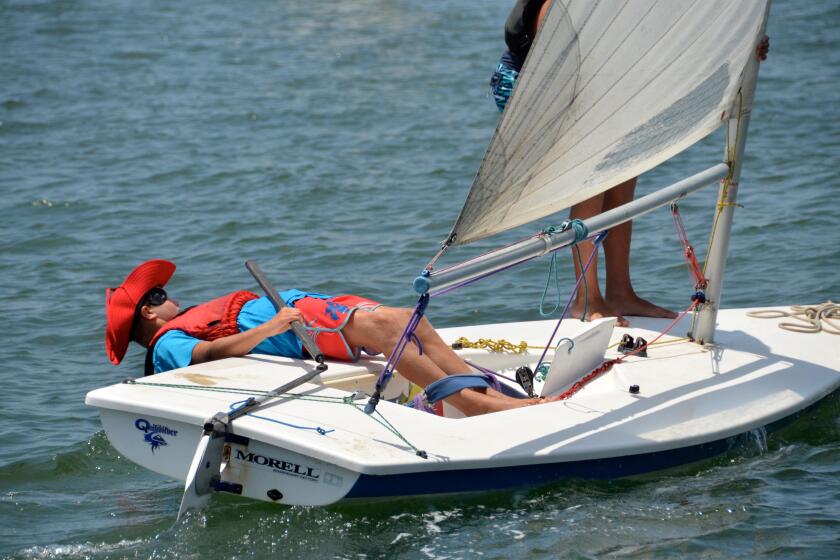Rescuers work to free whale tangled in net off Newport Beach; its whereabouts now unknown
The National Oceanic and Atmospheric Administration and the Pacific Marine Mammal Center of Laguna Beach worked until sunset Monday near the Wedge in Newport Beach to try to free a 30-foot gray whale tangled in a gill net.
The rescuers made several cuts to the net over three hours Monday before the whale swam away and they suspended their effort. On Tuesday, officials asked the public to keep an eye on the water for the whale so they can check on it.
Justin Viezbicke, coordinator of NOAA’s Long Beach-based California Stranding Network, said the whale did a fluke-up dive, in which it lifts its tail out of the water before diving deep into the ocean, as it moved away from a rescue boat Monday. The net, which was wrapped around its tail, had restricted the whale’s movement so severely that it had not been diving that way before.
The change gave Viezbicke an indication that the team’s efforts were successful.
“When it did that, we couldn’t see the big mass of gill net,” he said. “I think we at least got enough off to allow the net to loosen up as the whale is swimming around.”
Paddleboarders first saw the whale off Laguna Beach at about 10:45 a.m. Monday and followed it as it swam to Newport Beach.
The Ocean Explorer, a boat operated by Davey’s Locker in Newport Beach, and Ryan Lawler, who owns Newport Coastal Adventure, arrived on the scene after hearing about the whale from a NOAA rescue team member.
Lawler flew his drone to determine how severely the whale was entangled. About 150 feet of line trailed behind it, he said.
“It was definitely having trouble swimming,” Lawler said.
Netting can cause problems for whales if it isn’t removed quickly. Pressure from the net can cause necrosis in some of the tissue, which can result in tail loss, Lawler said.
Also, the effort expended in dragging the additional weight can cause the whale to tire more quickly and impede its ability to find food, he said.
“It’ll end up starving if it has to carry that weight around unnecessarily,” Lawler said.
Gray whales, which have the longest migration of any mammal, usually spend the summer feeding on plankton in chilly Alaskan waters. At this point in the year, the whales usually are migrating to warmer waters off Baja California, experts say.
According to data collected by NOAA, reports of entangled whales are rising. In 2016, 71 cases were reported off Washington, Oregon and California, the highest annual total for the West Coast since the agency began collecting such data in 1982.
The increase likely can be attributed to changes in whale abundance and distribution, shifting patterns in human activities like fishing, and increased reporting from the public, according to NOAA.
To report an entangled whale, call (877) SOS-WHALE (767-9425) or notify the U.S. Coast Guard by boat on Channel 16.
Twitter: @HannahFryTCN
UPDATES:
2:10 p.m. Dec. 12: This article was updated with additional details.
This article was originally published at 5:20 p.m. Dec. 11
All the latest on Orange County from Orange County.
Get our free TimesOC newsletter.
You may occasionally receive promotional content from the Daily Pilot.




